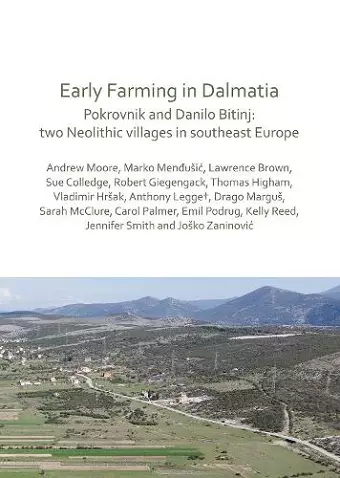Early Farming in Dalmatia
Pokrovnik and Danilo Bitinj: two Neolithic villages in south-east Europe
Andrew Moore author Marko Mendusic author
Format:Paperback
Publisher:Archaeopress
Published:11th Mar '19
Currently unavailable, our supplier has not provided us a restock date

Contributions by Lawrence Brown, Sue Colledge, Robert Giegengack, Thomas Higham, Vladimir Hrsak, Anthony Legge†, Drago Margus, Sarah McClure, Carol Palmer, Emil Podrug, Kelly Reed, Jennifer Smith, and Josko Zaninovic. The origins and spread of farming are vital subjects of research, notably because agriculture makes possible our modern world. The Early Farming in Dalmatia Project is investigating the expansion of farming from its centre of origin in western Asia through the Mediterranean into southern Europe. This multidisciplinary ecological project combines comprehensive recovery of archaeological materials through excavation with landscape studies. It addresses several key questions, including when and how farming reached Dalmatia, what was the nature of this new economy, and what was its impact on the local environment. Excavations at Danilo Bitinj and Pokrovnik have demonstrated that their inhabitants were full-time farmers. The two sites were among the largest known Neolithic villages in the eastern Adriatic. A comprehensive program of AMS dating indicates that together they were occupied from c. 8,000 to 6,800 cal BP. Our research has begun to illuminate the details of their farming system, as well as the changes that took place in their way of life through the Neolithic. Their economy was derived from western Asia and it is likely that their ancestors came from there also. It was these people who brought agriculture and village life to the Adriatic and to the rest of the central and western Mediterranean. Once in place, this farming economy persisted in much the same form from the Neolithic down to the present.
'A summary chapter on the lifeways of the people of these villages is a thoughtful conclusion to the work. Their economy was based on full-time mixed farming and transhumance, with little dependence on wild foods, and with some trade in goods including obsidian. The likely cycle of the year for these farmers and herders is eloquently described in a way that gives the reader a feeling of having at least a small window of insight into the lives of people in these long-lost cultures. This research should be of interest to anyone studying Neolithic Eurasia.' – Wendy L. Applequist (2020), Economic Botany
-- Wendy L. Applequist * Economic BotaISBN: 9781789691580
Dimensions: 245mm x 174mm x 6mm
Weight: 330g
120 pages